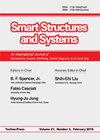与OMA一起监测标志性的遗产建筑:米兰大教堂的主尖塔
IF 2.2
3区 工程技术
Q2 ENGINEERING, CIVIL
引用次数: 3
摘要
米兰大教堂最引人注目的结构元素之一是其主尖塔,建于1769年,由坎多利亚大理石建造。主尖塔高约108米,支撑着圣母玛利亚雕像,高约40米,矗立在主圆顶周围的八角形提布里奥上。塔尖的结构布置包括一根中心柱,该中心柱通过螺旋楼梯连接到8根外围柱上,每根柱由反飞扶壁加固。金属夹具和销钉连接大理石块,金属杆连接周边立柱和中心核心。米兰大教堂最近安装了一个大型监测系统,包括位于主尖塔三层的地震仪和温度传感器,以及位于尖塔顶部的气象站。在简要介绍了主尖塔的历史背景和安装在该结构中的传感装置的描述后,本文重点研究了尖塔的动态特性及其在大约16个月的时间跨度内的演变。结果表明:(a)在1.0-7.0Hz的频率范围内,可以自动检测到高密度的振动模式;(b) 较低识别的模式对应于大教堂的全局模式;(c) 谐振频率在时间上的正常演变以环境效应(温度和风)引起的明显波动为特征;(d) 尤其是谐振频率对温度的依赖性非常独特,并揭示了金属元素在整体动力学行为中的关键作用;(e) 尽管环境变化对共振频率产生了显著影响,但仅输出环境影响的去除和新颖性分析可以有效地监测结构状况。本文章由计算机程序翻译,如有差异,请以英文原文为准。
Monitoring an iconic heritage structure with OMA: the Main Spire of the Milan Cathedral
One of the most remarkable structural elements characterizing the Milan Cathedral is its Main Spire, built in Candoglia marble and completed in 1769. The Main Spire, reaching the height of about 108 m and supporting the statue of the Virgin Mary, is about 40 m high and stands on the octagonal tiburio erected around the main dome. The structural arrangement of the spire includes a central column which is connected through a spiral staircase to 8 perimeter columns and each column is stiffened by inverse flying buttress. Metallic clamps and dowels connect the marble blocks and metallic rods connect the perimeter columns to the central core. A large monitoring system was recently installed in the Milan Cathedral, including seismometers and temperature sensors at 3 levels of the Main Spire as well as a weather station at the top of the spire. After a concise historic background on the Main Spire and the description of the sensing devices installed in this structure, the paper focuses on the dynamic characteristics of the spire and their evolution during a time span of about 16 months. The presented results highlight that: (a) a high density of vibration modes is automatically detected in the frequency range 1.0-7.0 Hz; (b) the lower identified modes correspond to global modes of the cathedral; (c) the normal evolution in time of the resonant frequencies is characterized by clear fluctuations induced by the environmental effects (temperature and wind); (d) especially the dependence of resonant frequencies on temperature is very distinctive and reveals the key role of the metallic elements in the overall dynamic behavior; (e) notwithstanding the remarkable effects exerted by the changing environment on the resonant frequencies, output-only removal of environmental effects and novelty analysis allow an effective monitoring of the structural condition.
求助全文
通过发布文献求助,成功后即可免费获取论文全文。
去求助
来源期刊

Smart Structures and Systems
工程技术-工程:机械
CiteScore
6.50
自引率
8.60%
发文量
0
审稿时长
9 months
期刊介绍:
An International Journal of Mechatronics, Sensors, Monitoring, Control, Diagnosis, and Management airns at providing a major publication channel for researchers in the general area of smart structures and systems. Typical subjects considered by the journal include:
Sensors/Actuators(Materials/devices/ informatics/networking)
Structural Health Monitoring and Control
Diagnosis/Prognosis
Life Cycle Engineering(planning/design/ maintenance/renewal)
and related areas.
 求助内容:
求助内容: 应助结果提醒方式:
应助结果提醒方式:


